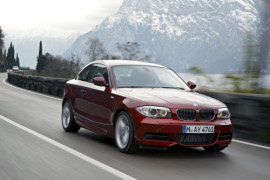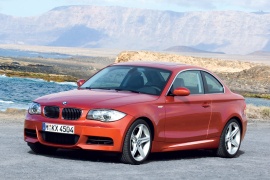BMW 1 Series Coupe Models/Series Timeline, Specifications & Photos
First production year: 2007
Engines: Diesel, Gasoline
Body style: Coupé (two-door)
In 2010, BMW gave the 1 Series Coupe a last update for the 2012 model year before it changed the generation in 2013, adding significant yet subtle changes on the exterior, interior, and under the hood.
The German automaker introduced the 3 Series in 1975 as a replacement for the 02 lineup. That compact-executive sedan grew in size over the years. By 2010, the well-known Bimmer was already an appreciated but expensive vehicle. Meanwhile, BMW cooked and delivered the 1 Series as a five-door hatchback in 2004 and then as a three-door, coupe, and convertible in 2007. These were priced lower than its larger sibling, and the automaker claimed that it was a legitimate successor to the 02 lineup from the late 60s and early 70s. The coupe was warmly welcomed by customers, albeit its sales were not significant. As a result, the automaker decided to give the car a second chance, and despite the world financial crisis that emptied car manufacturers’ pockets, it refreshed it substantially.
At the front, even though the headlights kept their original shape and size, their interior was upgraded. As a result, the 1 Series came with standard or available Adaptive Xenon headlamps, depending on the engine. In addition, the automaker introduced cornering lights to make nighttime driving safer. Another significant upgrade was noticed on the lower side of the bumper, where BMW installed a redesigned apron. It featured an upside-down trapezoidal air intake in the middle flanked by functional side scoops. These grabbed air and diverted it via vents inside the wheel wells to create an air curtain. This technique lowered air turbulences and led to a better drag coefficient.
From its profile, there were no significant updates for the 2012 BMW 1 Series. But still, the car manufacturer added redesigned side sills that allegedly reduced the ground effect and made the air under the vehicle’s floor run smoother. The automaker kept a few things, such as the long, frameless doors and the arched Hofmeister kick at the back of the greenhouse. Behind it, the short deck was adorned by a small lip spoiler on the trunk lid. Depending on the engine version, the 1 Series featured a single oval or twin-round exhaust that peaked under the bumper. Furthermore, the 135i received a standard M Aerodynamic Kit.
Inside, the 2012 BMW 1 Series was offered with either Leatherette or rich Boston Leather upholstery. This treat was unavailable for most other vehicles in the segment. The dashboard, on the other hand, remained largely unchanged. It still sported the same retractable infotainment screen atop the center stack, but the controls for the HVAC system were integrated with soft-touch materials. Between the front bolstered seats, the 1 Series featured a center console that housed the iDrive controller and the gear stick or the gear selector, depending on the options.
However, the most significant changes were those that customers couldn’t see but could feel. The revised suspension and the electronically controlled differential transformed the pocket rocket 135i into a genuine sports car. Furthermore, BMW replaced the formerly used inline-six powerplant for the 135i with a newer version named N55 (instead of the previous N54) and also sold a 135is version that pumped out 325 PS (320 hp).
BMW 1 Series Coupe (E82) 120i 6AT RWD (170 HP)
BMW 1 Series Coupe (E82) 120i 6MT RWD (170 HP)
BMW 1 Series Coupe (E82) 125i 6AT RWD (218 HP)
BMW 1 Series Coupe (E82) 125i 6MT RWD (218 HP)
BMW 1 Series Coupe (E82) 128i 6AT RWD (230 HP)
BMW 1 Series Coupe (E82) 128i 6MT RWD (230 HP)
BMW 1 Series Coupe (E82) 135i 6MT RWD (306 HP)
BMW 1 Series Coupe (E82) 135i 7AT RWD (306 HP)
In 2007, BMW made a surprising move and introduced a two-door version of the 1 Series when it launched the E82, which became the only premium coupe in the small-sized segment.
When the German automaker launched the first generation of the 3 Series in 1975, that model became an instant hit thanks to its low price, good performance for top versions, and fuel efficiency for the lower-powered ones. That success continued with the second generation, the E30, that followed in 1982. But all these new generations grew up in sizes and prices. As a result, young customers couldn’t afford them anymore. To gain back some of its lost customers, BMW introduced the 1 Series in 2004 as an affordable vehicle. Furthermore, besides the three- and five-door hatchback versions, the automaker also offered it as a two-door coupe, also known as the E87.
Maybe it wasn’t the best-designed BMW ever, but the E82 impressed its customers with its front fascia. The automaker offered it with either a standard or an M-package look. Still, both shared the same organic-shaped headlights that resembled those from its bigger sibling, the 3 Series. While the lower grade got a simple bumper with an apron that sported a rectangular lower grille flanked by a pair of scoops that housed the fog lamps, the M-package version featured a trapezoidal center air intake and a lip spoiler underneath the bumper.
The car’s profile revealed a raked windshield followed by an arched greenhouse that ended into a sloped down rear window onto the short deck. Its frameless doors and fixed rear windows resembled the lines of the first generation of the 3 Series. Depending on the trim level, the car sported aerodynamic side skirts and large wheels, while at the back, a duck-tail adorned the trunk. Furthermore, the rear bumper featured a lower-mounted diffuser with single or double side exhausts, depending on the engine version.
Inside, BMW offered the vehicle in a few grades, with either comfort or M sports seats for the front passengers. The driver fronted a narrow instrument cluster where the speedometer and tachometer took most of the area, including the fuel level and engine temperature gauges at their bottom. Base versions featured single-zone manual air-conditioning, while top versions provided dual-zone automatic climate controls. The 1 Series could also be equipped with a retractable screen for an infotainment system, which is folded onto the dashboard’s top. In the back, there was hardly any room for adult-size passengers, but those two seats could still be used for short distances.
Under the hood, BMW installed a wide choice of diesel and gasoline engines ranging between 143 PS (141 hp) and 306 PS (302 PS). Power went to the rear wheels via either a six-speed manual or a six-speed automatic, depending on the option.

